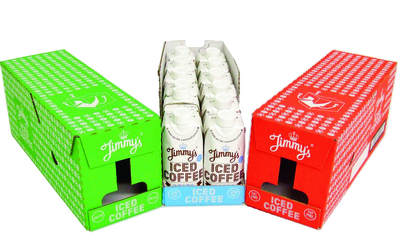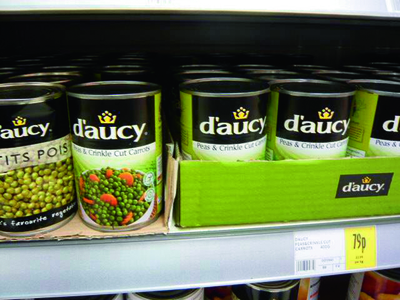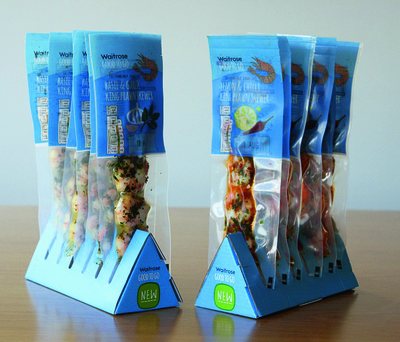RRP solution for Waitrose own-label prawn skewers
Retail-ready packaging has been the making of corrugated, elevating its status from dull but worthy basic brown box to one with standout shelf appeal. So what’s next for the format, asks Des King.
Firstly, an important distinction: although they are often referenced in the same breath retailready and shelf-ready packaging – RRP and SRP respectively – undertake totally separate functions, explained Asda packaging services corrugated director, Brian Gibbs.
And as the one-time co-chairman of the Efficient Consumer Response (ECR) working committee that developed the retail-ready concept and established the functional guidelines for its implementation some two decades ago, Mr Gibbs knows better than most that these differences are far from being merely a matter of semantics.
‘Shelf-ready is a transit packaging solution for collation and distribution that might end up by chance on shelf. Retail-ready packaging adheres to the ‘five easies’ and can only be achieved through considered design. It starts with the customer and works back through the supply chain, whereas SRP originates at the end of the production line.’
The ‘five easies’ (for anyone unfamiliar with the collective) summarise the key criteria that a retail-ready pack is required to fulfil, ie to be easy to identify back of store, easy to be placed on shelf, easy to open (by the store staff), easy to shop (customer), and easy to dispose of post use. It is a classic win-win formula that benefits the entire supply chain, not least the retailer by accelerating the progress of items from goods inward to on shelf: a 50 metre one-way trip that can seriously impact upon margin should it incur unnecessary time and personnel costs.
And it is a format that the corrugated sector is particularly adept in delivering, claimed the Confederation of Paper Industries (CPI) director of packaging affairs, Andy Barnetson. ‘A well-crafted RRP solution not only reduces retailer cost and time in shelf management, but also acts as an eye-catching, practical brand ambassador.
‘The continuous improvement in retail-ready packaging is testament to the extent to which the corrugated industry is listening and is taking an innovative approach towards identifying ways in which we can be the most effective, whether that is via product design or production efficiencies. The thinking is what makes the process better.’
Ready reckoning
No format is so successful that it can’t be improved upon, not least through the development of new flute specifications that are better engineered to minimise shadow effect when printed and allow for the inclusion of more userriendly perforations.
Whilst DS Smith’s R flute, for example, has a similar amount of fibre as a standard B flute, it also has a lower calliper that makes it thinner but still provides the requisite amount of strength and stability.
Additionally forming a more receptive base for solid colour is the knock-on effect of being able to produce a flatter board through using more flutes per square metre of surface area.
A case in point is the high quality flexo-printed retail ready pack produced by DS Smith South-West in R flute for start-up brand Jimmy’s Iced Coffee, now equally at home on the shelves of high-end retail outlets, such as Fortnum & Mason and Harvey Nichols, as it is in the chill section of Waitrose or as an on-the-go pick me up from a BP service station.
‘We’ve been really pleased with the results as the pack has gone down very well with our buyers, and it is certainly enhanced our appreciation of the importance of secondary packaging and its role in the product development process,’ said brand owner, Jim Cregan. ‘We wanted to make the product clearly identifiable so it was very important for the product to be presented on the supermarket shelf in the best possible way.’
Belying anecdotally reported reservations to the contrary, ‘Waitrose doesn’t particularly like having trays in the chill cabinet but prefer products to be stacked individually as it looks tidier,’ noted Mr Cregan when the new pack was first introduced last year. The UK’s sixth largest grocery retailer is now actively exploring opportunities for its application, said packaging development manager, Jonathan Couper. ‘The in-store experience for the customer and their interaction with the packaging, and so the brand, is key, and we have not wanted to put any potential barriers in the way of this.
‘In principle, however, Waitrose are not against the use of RRP, in fact in certain areas we are keen to exploit them more as there are clearly big benefits for both our customers and the business when they are used in the correct context.’
The retailer is currently finalising its own RRP guide to provide better support for its suppliers: ‘with robust principles that will mean that we deliver a genuine benefit for all the stakeholders,’ added Mr Couper.
Hopefully, these will ensure there is no obvious disconnect between the RRP solution and the primary packaging it helps to display – often reflective of when the development of the corrugated tray has been something of an afterthought, noted corrugated sector specialist consultancy Packology’s managing director, Robert Herridge.
‘Not on my watch and not as far as Asda own brand is concerned,’ said Mr Gibbs. ‘Part of the brief from Asda brand implementation to primary pack designers is not to put essential information below the 30 mm lip that is incorporated on all of our RRP packs.’
Further developments in store
‘Other improvements may be more a matter of thinking inside of the box, quite literally so,’ said Mr Herridge. ‘However comprehensively it fulfils the ‘five easies’, there willl often be an interval of time during which a retail-ready tray stands empty on the shelf. Indeed, with so many RRP applications now in use, the overall effect of a fixture stacked with boxes at varying stages of requiring replenishment can be quite off-putting to consumers.
‘I wonder if there isn’t some kind of opportunity for the application of a smart technology so that when the box has served its purpose, a message is automatically sent to the back of the store, rather than being left unattended until the shelf stacker next monitors that particular aisle?’
The Faraday Centre’s commercial manager, Andrew Revel, also focuses on the need to keep things neat and tidy within the fixture. ‘A real opportunity lies is producing something that is a high-quality item that not only combines the cost-saving, efficiency and sustainability benefits of existing formats but also has consumer appeal in terms of both how it works and how it presents the products.
 DS Smith provided this flexo printed RRP solution for Jimmy’s Iced Coffee
DS Smith provided this flexo printed RRP solution for Jimmy’s Iced Coffee
‘Take that to its logical conclusion and rather than looking at something that is in a box or else that is presenting one line, why couldn’t you look at fixture-based retail-ready packaging for certain brands or categories where you could replenish an entire section or indeed the entire fixture rather than individual products. You could achieve standardisation across your retail formats that would create conformity and acceptance with the consumer.’
Whilst the breadth of choice between competing brands would seem to militate against such an eventuality within the average supermarket, it could be a potential solution for the expanding number of smaller convenience outlets (C stores) stocking 1,000 rather than 40,000 SKUs, and where a smaller footprint has a direct correlation to pack size.
‘Although the same concepts of RRP apply, there will be some slight differences: not just fewer brands or SKUs due to restricted shelf space, but less storage facility at the back of the store meaning that RRP boxes will tend to go straight from lorry to shelf,’ noted Mr Barnetson. A fully stocked fixture that could be wheeled in and out could be the solution.
Adding value to the RRP proposition
Whilst the adoption of the more futuristic smart technologies currently under development, such as inductive inks, printed electronics, augmented reality and near field communications, is more likely to be driven by brand owners and retailers via primary packs, the indications are that corrugated RRP could be the next application to be targeted by digital print.
With the much heralded Landa nanographic presses now primarily focusing on folding cartons, there is a real opportunity for Sun Automation’s CorrStream digital inkjet system to take a lead in the short-run corrugated market, said global product manager (digital), Sean Moloney. ‘Whilst all of the digital activity in this sector has up until now been concentrated on producing point of sale and display material, the CorrStream is the first system to compete head on with flexo in printing corrugated trays for on-shelf usage.
‘On a cost basis, we can meet analogue systems in terms of speed, width and substrate; handling print runs of up to around 10,000 off with our wider 66 series machine (1345 mm). Even though our ink costs are currently more expensive, we gain in terms of not needing plates, reduced set up nd downtime.
 A poor example of retail ready packaging
A poor example of retail ready packaging
‘Whilst there is scope for improving the basics of RRP in terms of cost efficiency: flute specifications, design, pallet heights and doubleloading on wagons, etc, when it comes to what more can be done to encourage customers to buy from the package itself then that is where digital is coming into its own. Corrugated is following in the slipstream of what has been happening in say labels and flexibles. What you are able to do with digital print allows many more options to the brand owner and the retailer, we are looking forward to enabling box makers to take full advantage of that. RRP is nowhere near yet where it can be in the future once people introduce digital into their box plants.’
In addition to the 66 series, CorrStream will be available in two other widths: 783 mm and 557 mm (running at 75 m/min), which prospective adopters will be able to inspect at first hand when Sun Automation opens its dedicated worldwide demo centre in Bristol this April. In the meantime, Sun Automation is taking letters of intent now, and the first systems are on coursed for commercialisation by the end of the year.
‘We’re going to show customers how to use this equipment from the point they receive the artwork through to the printed sheet. There is much more to digital than simply turning on a machine and putting a piece of cardboard through,’ said Mr Moloney.
With the average batch quantity printed at an integrated sheet plant below 6,000 off, the CorrStream is being positioned as a single-digit percentage point cost-competitive alternative to conventional print. It does, however, have a further key capability to bring into contention, albeit not yet, he said.
‘Although the opportunity for applying variable data and delivering a customised solution is obviously going to be a big driver in the future, right now all the big corrugated manufacturers are far more focused upon reducing cost and improving margin.
All they can see in the current market – and there is no sign of it going away – is systems running up to seven or more colours on the back of increased set-up costs because batch quantities are reducing. Supermarkets want more colour and vibrancy in store.
‘We’ve worked hard to be cost competitive at the start; we can overlay that with all the advantages of variable data, etc, in due course.
Those attributes that are specific to digital will come into play when the customer is ready,’ concluded Mr Moloney.






